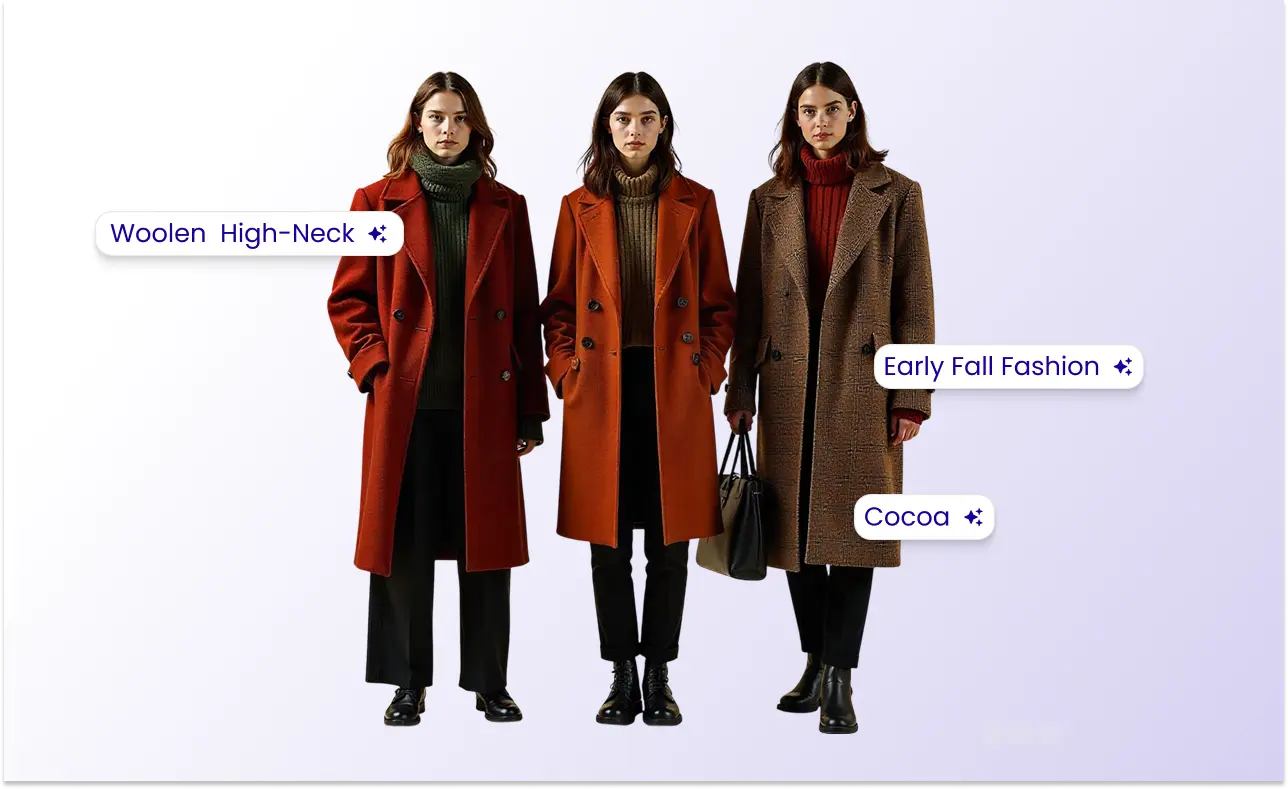
Every fall has its signature look, and this year, it’s all about feeling the fashion. Think textured wool blazers, ribbed knits, tweed coats, and warm caramel tones that practically smell like cinnamon lattes.
But here’s the catch: shoppers don’t just see these trends, they search for them. And if your product data doesn’t capture those cozy, tactile details, your collection risks going unseen.
That’s where AI product data enrichment steps in. Retailers using Pixyle.ai’s automated tagging and enrichment tools have reported 95% increased productivity, faster product creation, and optimized workflows, all because AI in fashion retail makes the hidden details visible and searchable.
Let’s explore the top three fall trends for 2025, and show how your fashion product data can showcase your collection as beautifully as your designs.
🍂 1. Texture Is the Trend
This fall is tactile in every sense. Wool, tweed, ribbed cotton, boucle, they’re not just fabrics, they’re search terms. Shoppers want to feel the quality, even through a screen.
The problem? Many retailers’ catalogs don’t tell that story. Product descriptions stop at “sweater” instead of “ribbed knit sweater.” Metadata lists “coat,” but not “brushed wool coat.” Those missing words are missed opportunities.
With AI fashion tagging, you don’t have to rely on manual updates. Pixyle.ai automatically extracts fine-grain details from product images, identifying fabrics, textures, and even weave types. It turns your visual data into rich, searchable metadata, helping customers find exactly what they want.
- Pixyle insight: Brands using AI tagging improved the accuracy of texture- and fabric-level data by over 90%, boosting visibility for fall categories like knitwear and coats.
- Pro tip:
Use enriched keywords like ribbed knit, wool blend, textured tweed, brushed cotton across your catalog. They align with seasonal searches and help shoppers discover your products faster.
🍁 2. The Return of Warm, Earthy Tones
After years of minimalist palettes, Fall 2025 is bringing warmth back. Rust, ochre, cocoa, moss green, cinnamon red, these colors define the season. But there’s a quiet problem hiding in your fashion product data: inconsistency.
One retailer’s “mocha” is another’s “brown.” “Camel” and “sand” might live in separate filters. The result? Confusion in site search, missed filter hits, and frustrated shoppers.
AI product data optimization solves this by recognizing and standardizing color metadata. It can detect the actual tone in your product images and assign the right label consistently across your catalog. Even better, AI can group similar hues into seasonal color families like “Warm Neutrals” or “Autumn Tones.”
Pro tip:
Use AI trend analysis for fashion to align color naming with what shoppers are typing right now. “Rust” might outperform “terracotta,” and “olive” might beat “khaki.” Let data guide your palette.
🎒 3. Oversized Accessories That Make a Statement
Fall 2025 isn’t just about clothes, it’s about accessories that stand out. Oversized scarves, chunky hats, bold handbags, and statement belts add personality and flair, turning seasonal outfits into memorable looks.
However, these items often get lost in catalogs if metadata doesn’t highlight their unique qualities. Is the scarf chunky knit, cashmere blend, or plaid pattern? Is the tote structured, slouchy, or oversized? Missing or inconsistent tags prevent shoppers from finding them.
With AI-powered product tagging and AI product data enrichment, Pixyle.ai can automatically detect and tag key features, from size and shape to material and pattern. This makes every accessory searchable and discoverable, improving fashion product discovery and automated product tagging for your seasonal items.
Pro tip:
Enrich accessory metadata with keywords like oversized, chunky, statement, plaid, structured, cashmere. This ensures your catalog highlights both the product and the trend it represents, making it easy for shoppers to find fall’s standout pieces.
The Data Behind the Details
Every fall trend tells a story, but only if your data tells it too. Behind textures, colors, and silhouettes, metadata is what enables customers to find, compare, and fall in love with your products.
Manual tagging can’t keep up with seasonal launches or evolving shopper language. AI solutions for fashion product enrichment bring scalability, consistency, and actionable insights by:
- Detecting and tagging fabric, fit, tone, and style directly from images
- Standardizing metadata across your full catalog
- Aligning your inventory with live AI trend analysis for fashion and search data
Retailers using Pixyle.ai also report:
- 8–12% conversion uplift from better site search and filtering
- 10x ROI through time savings and increased sales
Make Fall 2025 Your Most Discoverable Season Yet
Fall is about richness, in textures, colors, and style. Your product data should reflect that richness, not hide it. With Pixyle AI’s tagging and enrichment solutions, every wool thread, tweed weave, and cinnamon hue becomes searchable, discoverable, and optimized for shopper intent.
AI doesn’t just follow trends - it understands them.
Ready to make your product data fall-ready? Explore how Pixyle.ai helps fashion retailers automatically tag, enrich, and optimize seasonal collections for better discovery, higher engagement, and stronger sales.
Discover Pixyle Ultimate Dress type Taxonomy Guide
Learn how to structure your catalog in a way that matches how people actually shop.


Boost your sales with AI product tagging
Optimize your eCommerce catalog to improve discovery and conversions.






